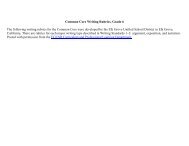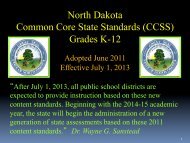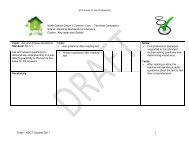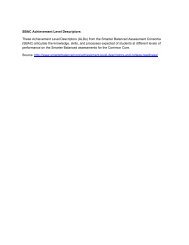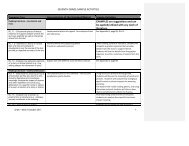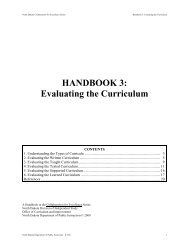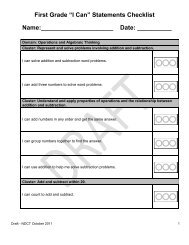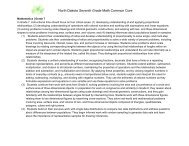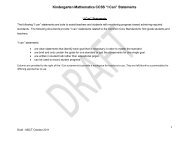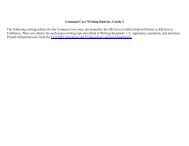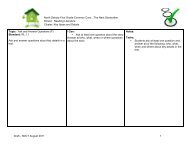A. ND Mathematics Content Standards, Grade 5 - ND Curriculum ...
A. ND Mathematics Content Standards, Grade 5 - ND Curriculum ...
A. ND Mathematics Content Standards, Grade 5 - ND Curriculum ...
Create successful ePaper yourself
Turn your PDF publications into a flip-book with our unique Google optimized e-Paper software.
How to read the grade level standards<br />
<strong>Standards</strong> define what students should understand and be able to do.<br />
Clusters are groups of related standards. Note that standards from different clusters may sometimes be closely related, because mathematics is a<br />
connected subject.<br />
Domains are larger groups of related standards. <strong>Standards</strong> from different domains may sometimes be closely related.<br />
Cluster<br />
Domain<br />
Code (grade, domain, standard)<br />
Standard<br />
Domain: Counting and Cardinality<br />
Cluster: Know number names and the count main sequence.<br />
main<br />
Code Standard Annotation<br />
K.CC.1 Count to 100 by ones and by tens. Pennies and dimes may be used to model ones and tens (<strong>ND</strong>)<br />
K.CC.2<br />
K.CC.3<br />
Count forward beginning from a given number within the known sequence (instead<br />
of having to begin at 1).<br />
Write numbers from 0 to 20. Represent a number of objects with a written numeral<br />
0-20 (with 0 representing a count of no objects).<br />
Number range for this skill should be up to 100. (CCSS)<br />
Example: Student is given a number within the range of 0 to 100. For example,<br />
use 56. Student must count forward in sequence from that number. “56, 57, 58,<br />
59” on so on. (<strong>ND</strong>)<br />
The characters of the code are separated by periods. The first characters represent the grade; the second characters represent the Domain and the last<br />
characters represent the number of the standard.<br />
These <strong>Standards</strong> do not dictate curriculum or teaching methods. For example, just because topic A appears before topic B in the standards for a given<br />
grade, it does not necessarily mean that topic A must be taught before topic B. A teacher might prefer to teach t opic B before topic A, or might choose to<br />
highlight connections by teaching topic A and topic B at the same time. Or, a teacher might prefer to teach a topic of his or her own choosing that leads, as<br />
a byproduct, to students reaching the standards for topics A and B.<br />
North Dakota <strong>Mathematics</strong> <strong>Content</strong> <strong>Standards</strong><br />
Based on the Common Core State <strong>Standards</strong><br />
Introduction 3 June 2011



